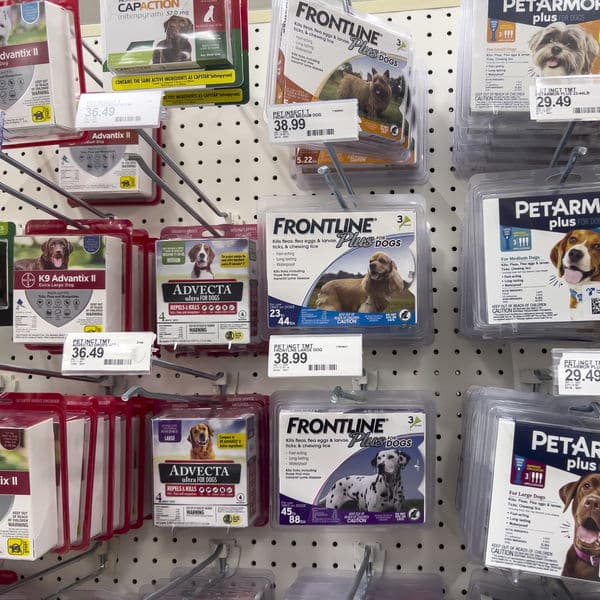Everything, Cats, Dogs, Health care, Pet Care
Are Topical Flea Treatments Safe?
Fleas can attach themselves to animals outdoors, move indoors with you, jump from one pet to another, spring from carpets or upholstered furniture, or hatch from dormant larvae in your home. They can live year-round indoors, and outdoors as well in warmer climates. Walk into a pet shop and you’ll find topical flea treatments ranging from flea spray to flea shampoos. They may work to rid your pet of fleas but are they safe?
Read the product warnings
Don’t take the product internally. Wash your hands with hot water and soap after using the product. Avoid inhaling it. Keep it away from children. These are common product warnings, but your pets can’t take these precautions. They’ll breathe in the insecticide, they’ll lick it off themselves, and it’ll be absorbed through their skin.
Flea collars constantly emit pesticides around your pet’s head, and everyone who picks up or hugs your pet will also breathe them in. According to Consumer Reports (August 1991), flea collars aren’t even effective against fleas.
If you use insecticides, use only products specified for use with the types of pets in your home. Some pesticides may be considered safe for dogs but not for cats. If a product is unsafe for cats, a cat can have a reaction to it if it’s applied to a dog in the same household.
Look at the ingredients
The ingredients listed as “active” ingredients are typically insecticides. Some insecticides destroy flea eggs and kill larvae, others kill adult fleas or prevent them from reproducing, and some just stun fleas.
These insecticides are used in sprays or other bug treatments for humans as well. They may also be used in insecticides for agricultural use. They’ve been tested on lab animals and declared safe.
However, they may have been found toxic at certain levels, or for certain animals. Human livers and various animal livers differ quite a bit in what is toxic to them. In addition, the cumulative effects of these ingredients may not have been studied. A product that apparently causes no harm with one treatment may cause damage with repeated use. It may also be unsafe if used in combination with other insecticides. Some common ingredients:
- Pyrethrins are derived from chrysanthemums, and are among the least toxic insecticides. However, inhaling them can cause respiratory problems, and skin contact can result in a rash or itching. While they’re considered safe (low in toxicity) for mammals and birds, they’re toxic to fish and bees. Typically used in flea shampoos and flea mousse, they don’t kill fleas, but paralyze their nervous systems, making it easier to comb them out of the pet’s coat.
- Permethrin, a synthetic pyrethrin, is more toxic than natural pyrethrins. It’s an endocrine disrupter, which means that it can contribute to thyroid and other endocrine disorders. It’s usually used in products for dogs only; cats are very sensitive to it. It’s toxic to wildlife.
- Piperonyl butoxide (PBO) is often used with pyrethrins to increase their effectiveness. It kills fleas and flea eggs. It’s also an endocrine disrupter. The pyrethrin/piperonyl butoxide combination is listed at the Centers for Disease Control and Prevention (CDC) site as a cause of systemic illness for humans.
- Methoprene prevents insects from reaching the adult stage and reproducing. It’s slightly toxic when absorbed through the skin. Test animals fed high doses over a period of time developed tumors or died, but there were no observable effects at lower doses.
Consider non-insecticidal methods
Fleas are resilient. However, we can eradicate them without using insecticides.
Area treatment
- Steam-clean carpets to kill flea eggs and larvae.
- Vacuum carpets, rugs, crevices, upholstery, and drapes regularly. Change the vacuum cleaner bag and seal it in a plastic bag immediately after vacuuming.
- Wash pet bedding regularly in hot water and detergent.
- If your pet travels in your car, vacuum the car regularly.
Skin and coat care
- Bathe your pet with a pet shampoo containing natural ingredients, which may soothe irritated skin and help repel fleas. If nothing else, the bath will drown any fleas on the animal. (Warning: tea tree oil, a common ingredient in natural products, is toxic to some cats.)
- Comb your pet’s coat with a flea comb. Dip the comb in water after catching fleas so that the fleas drown.
- Feed your pet a high-quality, nutritious diet. Healthy pets are less likely to attract fleas.
Attack with a plan
Use a variety of methods. If you have more than one pet in your household, apply the methods to all your pets and the areas where they go. A combination works best, but using more than one insecticide at a time isn’t recommended because of possible interactions between them. Attack at the first sign of fleas, and you’ll have fewer of them to fight.


